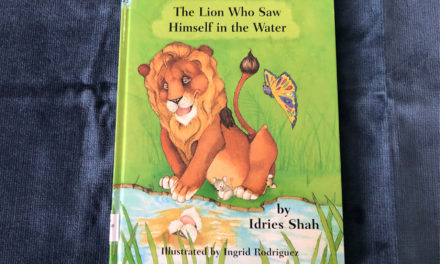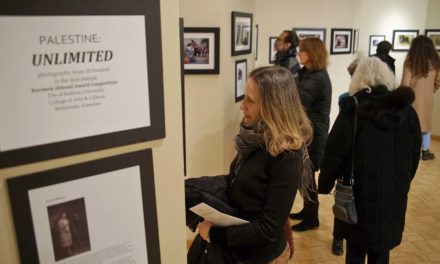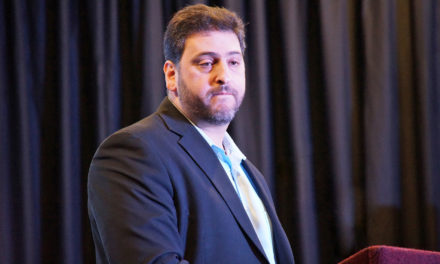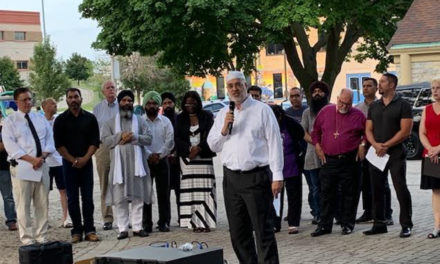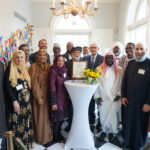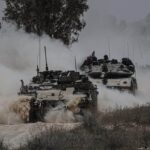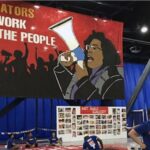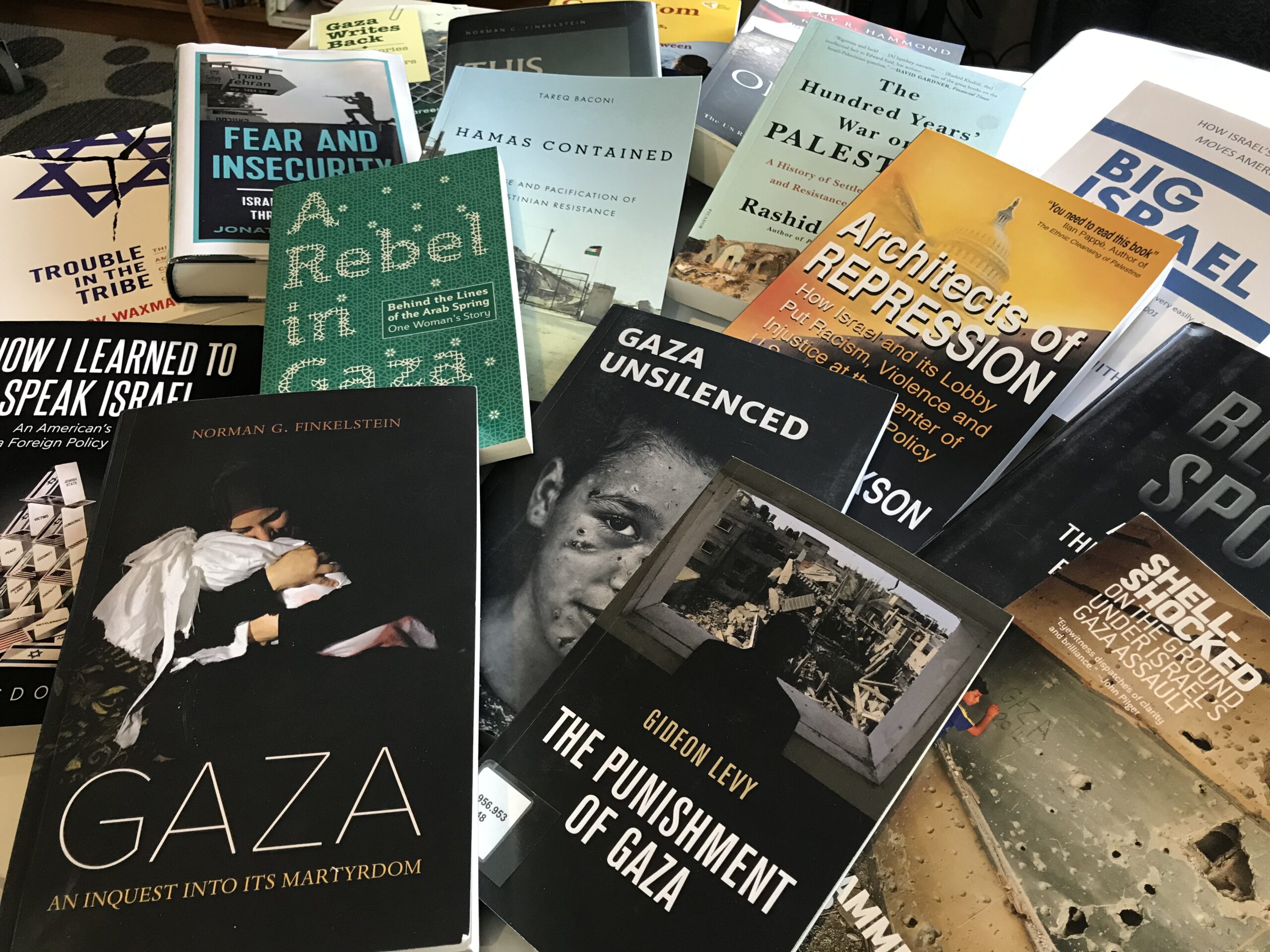
Photo by Cherrie Hanson
For a selection of books on Gaza, Palestine, U.S. foreign policy, and international law, visit the Islamic Resource Center library at 5235 S. 27th St., Greenfield, Monday-Friday 10 am – 6 pm. (Registration for a library card requires a current driver’s license)
The Hundred Years’ War on Palestine and Brokers of Deceit by Rashid Khalidi, The General’s Son: Journey of an Israeli in Palestine by Miko Peled, Wrestling in the Daylight: A Rabbi’s Path to Palestinian Solidarity by Brant Rosen and A History of Modern Palestine by Ilan Pappe, are for sale at the IRC bookstore.
Now available in the IRC library:
Fear and Insecurity: Israel and the Iran Threat Narrative by Leslie Jonathan. (Oxford University Press, 2023)
To observers of the Iran-Israel conflict, its vitriolic rhetoric might suggest an ancient hatred between Jews and Muslims-a biblical feud dating back hundreds, or thousands, of years. But this rivalry is a far more modern development.
Light in Gaza: Writings Born of Fire edited by Jehad Abusalim, Jennifer Bing, Michael Merryman-Lotze. (American Friends Service Committee, 2022) Light in Gaza is a seminal, moving and wide-ranging anthology of Palestinian writers and artists. It constitutes a collective effort to organize and center Palestinian voices in the ongoing struggle.
Architects of Repression: How Israel and Its Lobby Put Racism, Violence, and Injustice at the Center of U.S. Middle East Policy by Walter Hixson. Institute for Research, 2021. Walter L. Hixson since 2019 serves as columnist and contributing editor at the Washington Report on Middle East Affairs. This is his second book on the Israel lobby following Israel’s Armor: The Israel Lobby and the First Generation of the Palestine Conflict.
Gaza by Norman Finkelstein. (University of California Press, 2021) The Gaza Strip is among the most densely populated places in the world. More than two-thirds of its inhabitants are refugees, and more than half are under eighteen years of age. Since 2004, Israel has launched eight devastating “operations” against Gaza’s largely defenseless population. Thousands have perished, and tens of thousands have been left homeless. In the meantime, Israel has subjected Gaza to a merciless illegal blockade.
How I Learned to Speak Israel: An American’s Guide to a Foreign Policy Language by Alex McDonald. (Great Tree Publishing, 2021) How I Learned to Speak Israel is a guide for Americans wanting to better understand the Israel/Palestine situation. It is the author’s story of how he thought he knew about the situation and history only to learn that a lot of mythology was mixed in. This book provides tools and approaches for discerning what is fact from fiction. How I Learned to Speak Israel emphasizes the importance of the language used to create the understandings we have of the situation and how the language used by the media and politicians affects domestic US policy and our rights as Americans.
The Hundred Years’ War on Palestine by Rashid Khalidi. (Picador Paper, 2021) In 1899, Yusuf Diya al-Khalidi, mayor of Jerusalem, alarmed by the Zionist call to create a Jewish national home in Palestine, wrote a letter aimed at Theodore Herzl: the country had an indigenous people who would not easily accept their own displacement. He warned of the perils ahead, ending his note, “in the name of God, let Palestine be left alone.” Thus Rashid Khalidi, al-Khalidi’s great-great-nephew, begins this sweeping history, the first general account of the conflict told from an explicitly Palestinian perspective.
Blind Spot: America and the Palestinians, from Balfour to Trump by Khaled Elgindy. (Brookings Institution Press, 2019) The United States has invested billions of dollars and countless diplomatic hours in the pursuit of Israeli-Palestinian peace and a two-state solution. Yet American attempts to broker an end to the conflict have repeatedly come up short. At the center of these failures lay two critical factors: Israeli power and Palestinian politics.
Hamas Contained: The Rise and Pacification of Palestinian Resistance (Studies in Middle Eastern and Islamic Societies and Cultures) by Tareq Baconi. (Stanford University Press, 2018) Hamas rules Gaza and the lives of the two million Palestinians who live there. Demonized in media and policy debates, various accusations and critical assumptions have been used to justify extreme military action against Hamas. The reality of Hamas is, of course, far more complex. Neither a democratic political party nor a terrorist group, Hamas is a multifaceted liberation organization, one rooted in the nationalist claims of the Palestinian people.
A Rebel in Gaza: Behind the Lines of the Arab Spring, One Woman’s Story by Asmaa al-Ghoul. (DoppelHouse Press, 2018) A Palestinian journalist who grew up in the Rafah refugee camp in Gaza, Asmaa al-Ghoul offers a rare view of a young woman coming into her own political and secular beliefs amidst the region’s relentless violence and under Israeli occupation. She has been called “too strong minded,” frequently criticized for not covering her hair and for being outspoken.
State of Terror: How Terrorism Created Modern Israel by Thomas Suarez. (Olive Branch Press, 2017) This book shows how the use of terror by supporters of the idea of a Jewish state in Palestine was systematic, routine, and accepted by Jewish leaders as necessary to achieve their aims.
Big Israel: How Israel’s Lobby Moves America by Grant F. Smith. (Institute for Research, 2016) The Israel lobby exerts incredible power and influence over America. Some identify only one organization, the American Israel Public Affairs Committee (AIPAC), as “the lobby” citing its influence on Capitol Hill. This is wrong.
Obstacle to Peace: The U.S. Role in the Israeli-Palestinian Conflict by Jeremy Hammond. (Worldview Publications, 2016) Why has peace in the Middle East remained so elusive? Obstacle to Peace not only provides the answer, but also explains why you won’t hear it from US government officials or the mainstream media. With incisive and provocative analysis, Jeremy R. Hammond provides a meticulously documented account that explodes popular myths and deconstructs standard narratives about the Israel-Palestine conflict. For anyone seeking a better understanding of the conflict’s root causes, the true reasons for its persistence, and the way forward, Obstacle to Peace delivers the knowledge and insights to effect the paradigm shift required to achieve justice and peace in the Middle East.
Trouble in the Tribe: The American Jewish Conflict Over Israel by Dov Waxman. (Princeton University Press, 2016) Trouble in the Tribe explores the increasingly contentious place of Israel in the American Jewish community. In a fundamental shift, growing numbers of American Jews have become less willing to unquestioningly support Israel and more willing to publicly criticize its government.
Gaza Unsilenced edited by Refaat Alareer and Laila El-Haddad. (Just World Books, 2015) During Israel’s lengthy 2014 assault on Gaza, voices worldwide rose in stunned protest. Using numerous creative means, Palestinians and their allies bore witness to the Israeli attacks—and to the siege that has strangled Gaza ever since. Gaza Unsilenced foregrounds the words and images with which Gaza Palestinians recorded the pain, losses, and dislocations of the attacks, the continuing punishment of the siege, and their community’s resilience and dignity.
Shell Shocked: On the Ground Under Israel’s Gaza Assault by Mohammed Omer. (Haymarket Books, 2015) Operation Protective Edge, launched in early July 2014, was the third major Israeli assault on the Gaza Strip in six years. It was also the most deadly. By the conclusion of hostilities some seven weeks later, 2,200 of Gaza’s population had been killed, and more than 10,000 injured.
In these pages, journalist Mohammed Omer, a resident of Gaza who lived through the terror of those days with his wife and then three-month-old son, provides a first-hand account of life on-the-ground during Israel’s assault.
Gaza: A History by Jean-Pierre Filiu. (Oxford University Press, 2014) Gaza has become synonymous with conflict and dispute. Though only slightly larger than Omaha, Nebraska at 140 square miles, the small territory of Gaza has been a hot spot for bitter disputes between sparring powers for millennia, from the Ancient Egyptians up until the British Empire and even today.
Gaza Writes Back: Short Stories from Young Writers in Gaza, Palestine edited by Refaat Alareer. (Just World Books, 2014) Gaza Writes Back is a compelling anthology of short stories from fifteen young writers in Gaza, members of a generation that has suffered immensely under Israel’s siege and blockade.
Brokers of Deceit : How the US has Undermined Peace in the Middle East by Rashid Khalidi. (Beacon Press, 2013)
Winner of the 2014 Lionel Trilling Book Award
An examination of the failure of the United States as a broker in the Palestinian-Israeli peace process, through three key historical moments. For more than seven decades the conflict between Israel and the Palestinian people has raged on with no end in sight, and for much of that time, the United States has been involved as a mediator in the conflict. In this book, acclaimed historian Rashid Khalidi zeroes in on the United States’ role as the purported impartial broker in this failed peace process.
Gaza in Crisis: Reflections on the US-Israeli War Against the Palestinians by Noam Chomsky. (Haymarket Books, 2013) Israel’s Operation Cast Lead thrust the humanitarian crisis in the Gaza Strip into the center of the debate about the Israel/Palestine conflict. In this updated and expanded edition, Noam Chomsky and Ilan Pappé survey the fallout from Israel’s conduct in Gaza, including their latest incursions, and place it in historical context.
The General’s Son : Journey of an Israeli in Palestine by Miko Peled ; with a foreword by Alice Walker. (Just World Books, 2012) A powerful account, by Israeli peace activist Miko Peled, of his transformation from a young man who’d grown up in the heart of Israel’s elite and served proudly in its military into a fearless advocate of nonviolent struggle and equal rights for all Palestinians and Israelis. His journey is mirrored in many ways the transformation his father, a much-decorated Israeli general, had undergone three decades earlier.
Popular Resistance in Palestine : a History of Hope and Empowerment by Mazin B. Qumsiyeh. (Palgrave Macmillan, 2011) The Western media paint Palestinian resistance against Israeli occupation as exclusively violent: armed resistance, suicide bombings, and rocket attacks. In reality these methods are the exception to what is a peaceful and creative resistance movement. In this fascinating book, Dr Mazin Qumsiyeh synthesises data from hundreds of original sources to provide the most comprehensive study of civil resistance in Palestine.
Gaza Mom : Palestine, Politics, Parenting, and Everything in Between by Laila El-Haddad. (Just World Books, 2010) Laila El-Haddad takes us into the intense life and world of a busy Palestinian journalist who is both covering the story of Gaza and living it, with her young son. El-Haddad was in Gaza City in 2005, watching hopefully as the Israelis prepared a troop withdrawal from the Gaza Strip. She covered the January 2006 Palestinian elections—judged ‘free and fair’ by international monitors. But then, she watched aghast as the Israeli government, backed by the Bush administration, moved in to punish Gaza’s 1.5 million people for the way they voted by throwing a tough siege around the Strip.
The Punishment of Gaza by Gideon Levy. (Verso Books, 2010) Israel’s 2009 invasion of Gaza was an act of aggression that killed over a thousand Palestinians and devastated the infrastructure of an already impoverished enclave. The Punishment of Gaza shows how the ground was prepared for the assault and documents its continuing effects.
This Time We Went Too Far by Norman G. Finkelstein. (OR Books, 2010) For the Palestinians who live in the narrow coastal strip of Gaza, the Israeli invasion of December 2008 was a nightmare of unimaginable proportions: In the 22-day-long action 1,400 Gazans were killed, several hundred on the first day alone.
Understanding the Palestinian-Israeli Conflict : a Primer by Phyllis Bennis. (Olive Branch Press, 2009) If you have ever wondered “Why is there so much violence in the Middle East?”, “Who are the Palestinians?”, “What are the occupied territories?” or “What does Israel want?”, then this is the book for you. With straightforward language, Phyllis Bennis, longtime analyst of the region, answers basic questions about Israel and Israelis, Palestine and Palestinians, the US and the Middle East, Zionism and anti-Semitism; about complex issues ranging from the Oslo peace process to the election of Hamas to the Goldstone Report and the Palestinians’ UN initiatives.
Let Me Stand Alone: the Journals of Rachel Corrie edited and with an introduction by the Corrie family. (Norton & Co., 2008) Rachel Corrie’s determination to make a better, more peaceful world took her from Olympia, Washington, to the Middle East, where she died in 2003 as she tried to block the demolition of a Palestinian family’s home in the Gaza Strip. A twenty-three-year-old American activist, Corrie also possessed a striking gift for poetry, writing, and drawing.
The Israel Lobby and US. Foreign Policy by John J. Mearsheimer and Stephen M. Walt. (Farrar, Straus and Giroux, 2008) Originally published in the London Review of Books in March 2006, it provoked both howls of outrage and cheers of gratitude for challenging what had been a taboo issue in America: the impact of the Israel lobby on U.S. foreign policy. Now in a work of major importance, Mearsheimer and Walt deepen and expand their argument and confront recent developments in Lebanon and Iran. They describe the remarkable level of material and diplomatic support that the United States provides to Israel and argues that this support cannot be fully explained on either strategic or moral grounds.
Palestine Inside Out : An Everyday Occupation by Saree Makdisi. (Norton, 2008) Tending one’s fields, visiting a relative, going to the hospital: for ordinary Palestinians, such activities require negotiating permits and passes, curfews and closures, “sterile roads” and “seam zones”―bureaucratic hurdles ultimately as deadly as outright military incursion. In Palestine Inside Out, Saree Makdisi draws on eye-opening statistics, academic histories, UN reports, and contemporary journalism to reveal how the “peace process” institutionalized Palestinians’ loss of control over their inner and outer lives―and argues powerfully and convincingly for a one-state solution.
The Case for Palestine: An International Law Perspective by John Quigley. (Duke University Press, 2005) John Quigley brings a necessary international law perspective to bear on the seemingly intractable Israeli-Palestinian conflict in this updated edition of his important book. Since 2000, the cycle of bloodshed and retribution has spiraled increasingly out of control. Quigley attributes the breakdown of negotiations in 2000 to Israel’s unwillingness to negotiate on the basis of principles of justice and law. He argues that throughout the last century, established tenets of international law—and particularly the right of self-determination—have been overlooked or ignored in favor of the Zionists and then the Israelis, to the detriment of the Palestinians.
